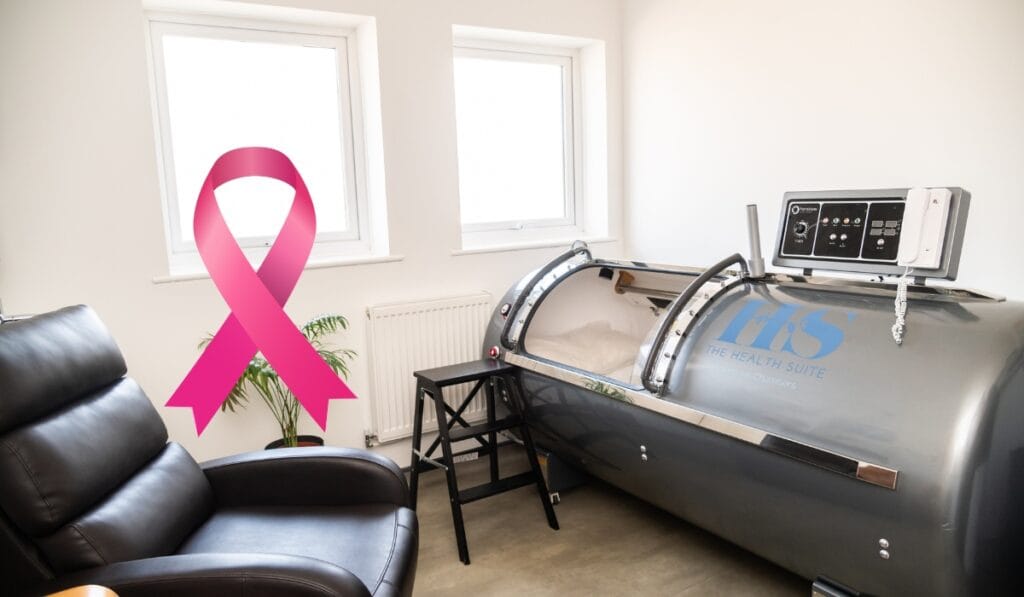Hyperbaric Oxygen Therapy (HBOT) involves breathing 100% oxygen within a pressurised chamber, which enhances oxygen absorption into the bloodstream due to the increased pressure. Traditionally used for conditions like decompression sickness, HBOT is now gaining popularity for treating a variety of other conditions, including alongside traditional cancer therapies.
In recent years, there has been growing interest and research into alternative therapies for cancer treatment, one of which is Hyperbaric Oxygen Therapy (HBOT). This oxygen-rich environment is believed to have several potential benefits for cancer patients, although research is still ongoing to determine its full effectiveness and safety in this context. (HBOT) is being explored in cancer treatment due to its potential to enhance traditional therapy and change the tumour environment. Research in this area is still new and evolving; however, some key findings are emerging.
How does HBOT help during cancer treatment?
- Low Oxygen in Tumours: Cancer tumours often have areas with low oxygen (hypoxia), which helps the cancer survive and grow.
- Role of Hypoxia: As tumours spread, they limit oxygen supply, which is common in almost all solid tumours and makes them harder to treat.
- Impact on Treatment: Many clinical reviews show that hypoxic changes ultimately limit prognosis. HBOT helps by increasing oxygen in these areas, making it harder for cancer cells to survive and spread.
- Enhancing Radiation Therapy: Studies have shown that higher oxygen levels from HBOT can make radiation therapy more effective, as radiation relies on oxygen to damage cancer cells. HBOT can also be used to treat radiation injuries. Read more about Radiotherapy and Hyperbaric Oxygen Therapy
- Supporting Chemotherapy: HBOT can improve the effectiveness of chemotherapy by increasing oxygen levels in tumours, making them less resistant to treatment.
- Improving Wound Healing: For cancer patients who have had surgery, HBOT can enhance wound healing and reduce infection rates due to its anti-inflammatory effects and increased oxygen supply.
- Palliative Care Benefits: In advanced cancer care, HBOT can alleviate symptoms and improve quality of life by promoting better oxygenation and reducing pain and inflammation.
- Combination with Diet: Preliminary animal studies and human trials suggest that combining HBOT with a ketogenic diet can slow tumour growth and enhance the effectiveness of conventional treatments.
Are there any contraindications?
Depending on the medication within chemotherapy, HBOT can be highly beneficial or strongly contradictory. If you are considering HBOT and wish to discuss this further, please contact us for a consultation.
Click here to learn more about Hyperbaric Oxygen Therapy and book an appointment.
References
- Chen, S., Tsuneyama, K., Yen, M., Lee, J., Chen, J. & Huang, S. 2021, “Hyperbaric oxygen suppressed tumor progression through the improvement of tumor hypoxia and induction of tumor apoptosis in A549-cell-transferred lung cancer”, Scientific reports, vol. 11, no. 1, pp. 12033.
- Hanahan, D. & Weinberg, R.A. 2011, “Hallmarks of cancer: the next generation”, Cell, vol. 144, no. 5, pp. 646-674.
- Jing, X., Yang, F., Shao, C., Wei, K., Xie, M., Shen, H. & Shu, Y. 2019, “Role of hypoxia in cancer therapy by regulating the tumor microenvironment”, Molecular cancer, vol. 18, pp. 1-15.
- Moen, I. & Stuhr, L.E. 2012, “Hyperbaric oxygen therapy and cancer—a review”, Targeted oncology, vol. 7, pp. 233-242.
- Ortega, M.A., Fraile-Martinez, O., García-Montero, C., Callejón-Peláez, E., Sáez, M.A., Álvarez-Mon, M.A., García-Honduvilla, N., Monserrat, J., Álvarez-Mon, M. & Bujan, J. 2021, “A general overview on the hyperbaric oxygen therapy: applications, mechanisms and translational opportunities”, Medicina, vol. 57, no. 9, pp. 864.
- Thews, O. & Vaupel, P. 2015, “Spatial oxygenation profiles in tumors during normo-and hyperbaric hyperoxia”, Strahlentherapie und Onkologie, vol. 191, no. 11, pp. 875.
- Zhang, L., Ke, J., Min, S., Wu, N., Liu, F., Qu, Z., Li, W., Wang, H., Qian, Z. & Wang, X. 2021, “Hyperbaric oxygen therapy represses the Warburg effect and epithelial–mesenchymal transition in hypoxic NSCLC cells via the HIF-1α/PFKP axis”, Frontiers in Oncology, vol. 11, pp. 691762.
- Poff, A.M., Ari, C., Seyfried, T.N. & D’Agostino, D.P. 2013, “The ketogenic diet and hyperbaric oxygen therapy prolong survival in mice with systemic metastatic cancer”, PloS one, vol. 8, no. 6, pp. e65522.
Hyperbaric Oxygen Therapy (HBOT) is a medical treatment that entails breathing pure oxygen in a specially pressurised chamber, which enhances oxygen delivery to tissues, facilitating healing and reducing inflammation.

